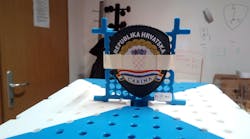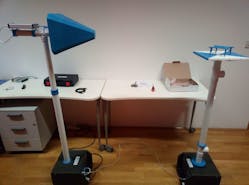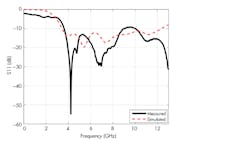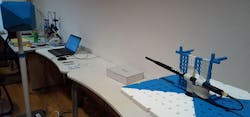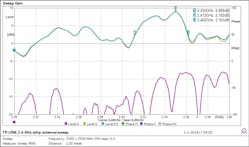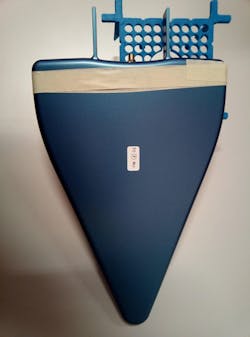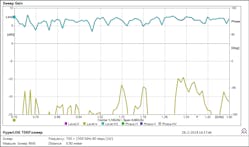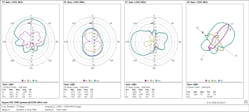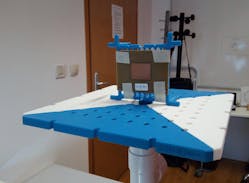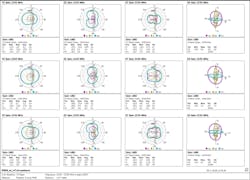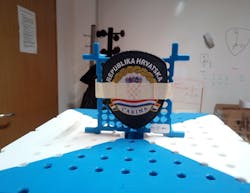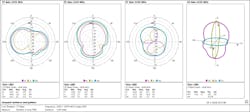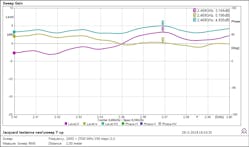Download this article in PDF format.
Antenna designers and researchers have often wished for better measurement tools to check their work. Even as computer-aided-engineering (CAE) simulation tools1-3 have improved over time, true validation of a design ultimately comes from fabricating and testing a prototype. Typical (or minimum) measurements of antenna characteristics include S-parameters and radiation patterns with further information on the antenna gain and efficiency, which usually calls for costly test equipment that may be outside the range of a designer’s budget. Fortunately, affordable antenna measurements are becoming more practical and readily available.
S-parameters can be measured in a limited fashion with a scalar network analyzer (SNA) and more completely with a vector network analyzer (VNA).4,5 Until recently, VNAs have been rather expensive test instruments, although smaller, less-costly units are emerging from several commercial suppliers.
Still, for full antenna characterization, some form of radiation pattern analyzer will also be needed and, fortunately, more affordable antenna radiation pattern analyzers have also entered the commercial market.6-8 For effective antenna radiation pattern measurements, the analyzer usually must be supported by an anechoic chamber and two antenna masts, for transmit and receive antennas, with the capability of rotating 360 deg.
Today, antenna designers can perform a wide range of antenna radiation measurements with the aid of a radiation measurement system (RMS) from the Netherlands-based firm MegiQ.9 Two versions of the RMS (Fig. 1) are available, for 0.6 to 4.0 GHz or 0.6 to 6.0 GHz. These frequency ranges cover many commercial wireless-communications applications.
1. This is how the MegiQ Radiation Measurement System (RMS) appears when it’s fully assembled and ready for testing antennas.
The RMS enables quick, easy measurements of three-dimensional (3D) radiation patterns (single-axis measurements are an option), as well as measurements of antenna gain, directivity, total efficiency, effective isotropic radiated power (EIRP), total radiated power (TRP), and field strength. Values can be measured for multiple frequencies during the single rotation of an antenna under test (AUT), simultaneously measuring horizontal (H) and vertical (V) radiated field components.
This capability to measure simultaneous H and V radiation field components can greatly speed the measurement process, either for studying two orthogonal patterns of cross-polarization measurements or for a dual-polarization antenna measurement. The analyzer can control the rotation of an AUT’s turntable with 2-deg. angular resolution and with measurement speed of 30 s/rotation. Integrated PC software provides a simple user interface to control the measurement functions, allowing a user to define various attributes: measurement distance; cable characteristic (either a total loss or a complete frequency characteristic by importing a Touchstone file); transmitter power; rotation control; how the results are displayed; data storage; or even the generation of a simple report.
The measurement distance between the transmit and receive sides is ranges from 0.8 to 3.0 m. For popular wireless frequencies (e.g., the 2.4-GHz band) and small antennas, very dependable results (confirmed by a comparison to results obtained by high-grade anechoic chambers and instruments10) are obtained at a separation distance of 90 to 110 cm even without an anechoic chamber. And that’s even with surrounding objects present in the measurement room, which can be seen in the enclosed figures.
Results are displayed on the computer screen in real time. As soon as a measurement is completed, it’s possible to see the radiation patterns for the chosen output parameters (i.e., field strength in dBµV/m or EIRP in dBm or antenna gain in dBi) as well as the maximum realized gain and antenna efficiency. Measured values for every measurement point can be also seen in the graphs.
For those not satisfied with the default plots, measurement results can be easily exported to a text file and then imported into a popular spreadsheet program for post-processing by the user and plotting in a user-preferred style. A user can choose between rotational measurements (single axis or three axes) that are then performed at a single (or multiple) discrete frequency or gain measurement. During this time, the turntable does not rotate, but the RMS tester performs frequency sweeping to analyze AUT characteristic as a function of a designated frequency range.
What’s in The Box
The RMS is equipped with several items that are often left as accessories by other instrument suppliers. Included with each analyzer (Fig. 2) are small parts that help simplify the assembly of the system and the measurements: a 3-m measuring tape; a screwdriver of an optimal length and size; a sticky (tesa) tape to fix the AUT to the turntable; and a roll of “TFR” stickers that are instrumental for proper orientation of an AUT on the turntable. These accessories enable a buyer to assemble a measurement system from the ground up a short time after opening the box.
2. A variety of accessory parts are shipped with each RMS tester in a small box.
Inclusion of the box of accessories with each RMS is indicative of the thoughtful design that went into the model RMS0640 used for antenna measurements. The PC software is extremely user-friendly and enables AUT measurements even without an anechoic chamber. The system is well thought out, even to the intelligent rotation of the turntable, which prevents overstretching of the interconnecting cables. All assembly instructions lead to the construction of an automated system fully capable of producing genuine antenna 3D radiation patterns.
The two sides of the RMS can be referred to as the antenna unit and the turntable unit (Fig. 1, again). The antenna unit contains an antenna base box (which stands on the floor) with inputs and outputs for power supply and data and control cables (communications links to a PC and the turntable unit, respectively), and carries a telescopic antenna mast (adjustable in height from 100 to 170 cm), on top of which a user mounts a pyramidally shaped measurement head and a MegiQ dual-channel receiver. The whole assembly of this side is carried out by two plastic pipes that provide the necessary height of the head and carry the antenna and the dual-channel receiver.
The measurement head contains a dual-polarization antenna such that the RMS can simultaneously measure the horizontal and vertical polarization of an AUT. Matching that, the dual-channel receiver mounted just behind the measurement head measures the two polarization components received by the dual-polarization antenna. In this way, a user instantly has information on the cross-polarization of a linearly polarized antenna or the axis ratio of a circularly (or elliptically) polarized antenna.11
By adding an optional generator output to the dual-channel receiver, the measurement system can generate test signals from the test receiver and measure passive devices under test (DUTs), such as passive antennas. Otherwise, test signals must be provided from an additional third-party signal generator. For an active device, the PC software enables a user to designate an external source as the RF test signal source for the measurements.
The other side of the RMS (Fig. 1, again) contains a turntable unit box (on the floor), a plastic pipe-based antenna mast (two-piece construction, to enable height adjustment from 70 to 130 cm), a rectangular 28- × 28-cm table punched with an array of holes through it (to accommodate a DUT with as much as 7.5-kg load), and a (small) object platform that’s being plugged into some of the base table holes. The purpose of the latter is to allow for easy placement of a DUT in a correct orientation, as defined by the RMS instructions.
The turntable unit contains a stepper motor that’s controlled by the PC software via the antenna unit box and USB and control cable that connect the PC, antenna unit, and turntable unit. The stepper motor achieves a full 360-deg. rotation in about 30 s, has smooth acceleration and deceleration, and quiet operation. For those testing heavier DUTs, MegiQ offers a heavy-duty table of 100- × 50-cm size, which can carry loads as large as 30 kg.
The RMS, as declared, will help a user have comfortable measurements when a distance between the two RMS masts is in the range from 0.8 to 3 m. The author has used the RMS for measurements at separation distances between 90 and 150 cm with good results. The separation adjustment, the antenna alignment, and the turntable “reference turn” could be completed quickly and easily.
To complete the measurement setup, a user will need a good-quality coaxial cable about 5 m long and 5 mm in diameter to connect the dual-channel receiver and a DUT. The cable passes through the predefined holes in the plastic pipes for the two masts. Such a cable is not included with the shipment of the RMS, but is available separately from MegiQ.
Software Side
PC software that comes with the RMS controls the measurement procedure for characterizing an antenna’s radiation pattern. The software contains simple and intuitive commands to control major steps of the measurement (Fig. 3). Using tabs at the bottom of the PC control screen, the user sets different options and input values. These include the “Measurement” tab for choice of measurement type, i.e. a single rotation (for a single pattern) or 3-axis rotation (for a 3D pattern and antenna parameters derived from it), or the “Sweep” (for gain vs. frequency). By choosing such tabs, test variables are selected, including the measurement distance between the two antennas and the source of the RF signal, the output power that will be used in a measurement, and the cable loss value (in dB) or the cable loss as a function of frequency as a Touchstone file.
3. PC software is included with each RMS tester to control the radiation measurement procedure.
For example, the “Rotation” tab establishes the desired test frequencies and the characteristics of the AUT rotation (i.e., the number of sample points and the choice between the continuous rotation and rotation with dwell time as well as the rotation in manual steps). The “Display” tab contains the frequencies at which results will be displayed using the “Addgraph,” “Update,” “Close Graphs,” or “Clear Data” buttons. Finally, an “Export” button opens an interface to quickly export results into a file for later customized processing. The windows with the plotted patterns currently have limited capabilities in rotating patterns, but this will be upgraded in future versions of the software.10
Another convenience is that the most-popular beam parameters are automatically displayed underneath the display graphs as soon as the final rotation is completed. At that point, a user is presented with the most relevant parameters: directivity, maximum realized gain (as well as the direction of a specific gain value, if desired, by hovering the mouse over any graph point), the realized efficiency, or the 3- and 10-dB beamwidths—all in just a few mouse clicks for any of the measured frequencies from the list.
While a few other tabs and buttons contain additional convenient features, this review focuses on the most important features. During the radiation pattern measurements, all tabs contain the “X Y Z” buttons, which are instrumental in instructing the software which rotational plane is to be measured. Closely related to that is the need for the user to correctly set a DUT on the table using the small object platform. This can pose the greatest challenge in learning to use the RMS properly and optimally, but can be learned within a few days.
Evaluating Examples
To understand the capabilities of the RMS, it was used to characterize a few commercial and prototype designs. The commercial antennas were a 2.45-GHz monopole from TP-Link and a log-periodic HyperLOG 7060 from Aaronia for use from 0.7 to 6.0 GHz.12
The two prototypes were developed in the laboratory: a 2.45-GHz rectangular microstrip patch antenna and a circularly polarized textile antenna for ISM-band use. These antennas represent a diversity of types for the RMS, with differences in size, polarization, and frequency range. For precision, a VNA-created .s2p Touchstone file was imported to describe the characteristics of the coaxial cable between the transmitter and receiver. The cable was a 5-m-long SMA coaxial cable from Delock.
4. This was the setup for measuring the commercial 8-dB, 2.45-GHz monopole antenna from TP-Link.
The 2.45-GHz monopole was measured first. It was placed on the object platform and the turntable for one measurement plane (Fig. 4). Go here to see a video of its rotation. To measure its gain over a wider frequency range (2.3 to 2.5 GHz), it was placed in a vertical orientation and the RMS was set to measure antenna gain from 2.3 to 2.5 GHz. The measurement results are shown in Fig. 5, which shows gain of 8.88 dB at 2.45 GHz. This closely matches the antenna’s specified gain of 8 dB. Since the RMS receiver simultaneously measures and plots both the horizontal (H) and vertical (V) field component, as well as the total (HV) component, the HV curve is relevant for the total gain.
5. The measured gain-versus-frequency responses for the commercial 8-dB, 2.45-GHz monopole antenna shows a good agreement with antenna specifications.
Three markers were placed to show the gain values around the operating frequency: marker 1 at the maximum gain and markers 2 and 3 at the gain of frequencies below (to the left) and above (to the right) of the maximum gain. Their values appear in the upper-right-hand corner of the plot window. In this version of the RMS software, the curves have predefined colors, while in upcoming software upgrades, it’s expected that the user will have the option of choosing the color for each curve.10
Next, the model HyperLOG 7060 log-periodic antenna from Aaronia12 was tested. It’s designed for use from 700 MHz to 6 GHz (Fig. 6). An auxiliary sticker placed on the top of the antenna helps a user correctly orient the antenna prior to the measurement of each cut-plane, which is essential while performing a 3D pattern scan with the RMS. The arrows and letters on the sticker indicate the necessary orientation of each axis label.
6. This commercial log-periodic antenna was tested on the RMS from 700 MHz to 6 GHz.
Although users can set their own coordinate system for a given DUT, it’s important to set the proper constellation of the axes, so that the orientation of the DUT corresponds to the settings in the measurement software for correct interpretation of the results. The swept antenna gain for this antenna was measured from 700 to 1500 MHz (Fig. 7), with gain varying between 5 and 7 dB (6 dB average). These results are about 1-dB higher than the specifications listed on the antenna’s datasheet.
7. These plots show the measured gain from 700 to 1500 for the log-periodic antenna.
This antenna’s radiation pattern was measured at 1500 MHz with patterns obtained in three orthogonal cut-planes (Fig. 8). The yz and xy planes correspond to the two major cut planes, which are the H and V axes, respectively (the x-axis is orthogonal to the antenna top plate, pointing upward, while the y-axis points forward through the tip of the antenna). The third cut-plane, the zx-plane, was measured to complete the procedure before the antenna parameters were evaluated.
8. These radiation patterns were measured for the three cut-planes of the commercial log-periodic antenna at 1500 MHz.
Although antenna efficiency is not listed in the product datasheet, these measurements revealed efficiency of 61.8%. The horizontal and vertical major 3-dB beamwidth lobes were measured at 60 and 80 deg., respectively, which are in close agreement with the values that can be derived from the patterns on the datasheet plotted for 1800 MHz, where they also have 3-dB beamwidths of about 60 and 80 deg. wide, respectively.
9. This test setup on the RMS measured the 2.45-GHz WLAN microstrip patch antenna.
The third test example deals with a homemade, rectangular-patch, microstrip 2.45-GHz WLAN antenna (Fig. 9). A “Top-Right-Front” orientation sticker was placed on the antenna’s top surface to help with the correct orientation of the antenna with respect to the RMS rotation sequence and the control software. Fig. 10 shows the results at three frequencies (2.33, 2.43, and 2.53 GHz), measured simultaneously during a single procedure, which is extremely efficient.
10. These radiation patterns were measured simultaneously at three different frequencies for the 2.45-GHz WLAN microstrip patch antenna.
Using this extremely efficient measurement system has been a tremendous benefit in the design and evaluation of a novel, circularly polarized wearable antenna under development (Fig. 11) for use within the ISM band.13 Fig. 12 shows radiation pattern measurements for this wearable antenna at 2430 MHz. Fig. 13 shows gain-vs.-frequency response measurements.
11. This is a prototype wearable sleeve-badge antenna being developed with the help of the RMS tester.
12. These radiation patterns were measured for the prototype circularly polarized wearable antenna.
13. These gain-vs.-frequency responses were measured for the prototype circularly polarized wearable antenna.
In addition to total directivity, gain, and efficiency displayed under the 3D gain plot (the first plot from the right), beam statistics are available by clicking on the beam button on the RMS display. Statistics for H and V radiated field components as well as for total field components (computed as the vector sum of the H and V measurements) include maximum gain level, direction of maximum gain, 3-dB beamwidth, direction of the 3-dB beam center, 10-dB beamwidth, direction of the 10-dB beam center, and front-to-back ratio. Minimum, maximum, and average values for gain and directivity can also be displayed.
Simultaneous measurement of both the H and V antenna radiation field components, especially for a linearly polarized antenna, has the benefit of instantly showing the effect of the cross-polarization in both major cut-planes of interest. However, since H and V radiation field components are measured simultaneously (i. e., they are in phase), the cross-polarization of a circularly polarized AUT cannot be obtained explicitly by this measurement but requires a post-calculation in a spreadsheet.10
References
1. HFSS simulation software, Ansys, May 16, 2018.
2. Microwave Studio simulation software, Computer Simulation Technology, as used by Dassault Systems, May 16, 2018.
3. FEKO software, Altair, May 16, 2018.
4. Rohde & Schwarz, May 16, 2018.
5. Keysight Technologies, May 16, 2018.
6. Signal Hound, May 16, 2018.
7. SynthNV signal generator, Windfreak Technologies, October 25, 2017.
8. pocketvna, May 16, 2018.
9. MegiQ, May 16, 2018.
10. R. Denker, private communication, 2018.
11. C. A. Balanis, Antenna Theory: Analysis and Design, 4th ed., Wiley, New York, 2016.
12. Aaronia, May 25, 2018.
13. M. Joler and M. Boljkovac, “A sleeve-badge circularly polarized textile antenna,” IEEE Transactions of Antennas & Propagation, Vol. 66, No. 3, 2018, pp. 1576–1579.
